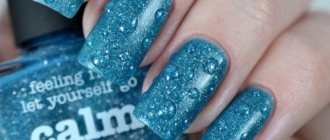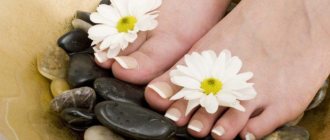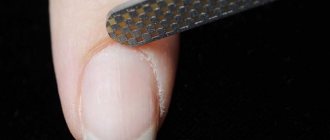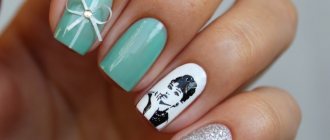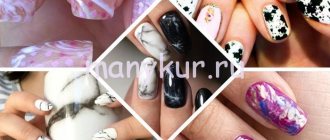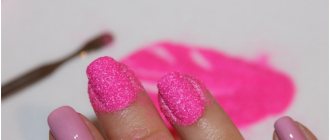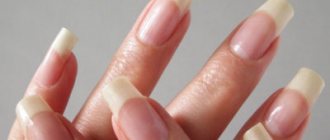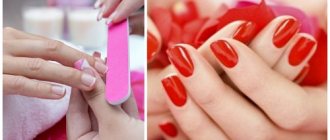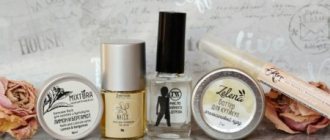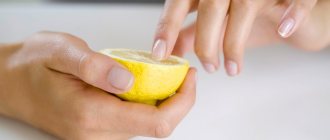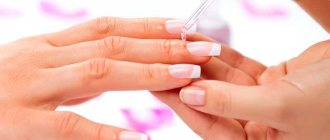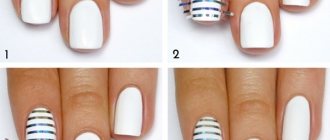Types of hand massage that a nail technician should master
Massage is a mechanical and reflex effect on the skin of the arms, hands and wrists using rubbing, pressure, stroking and vibration techniques. There is medical and cosmetic massage.
Medical massage is indicated as a restorative therapy after strokes, fractures, pinched nerve endings, and other muscle injuries. Can only be performed by specialists with medical education and is not recommended for use by nail technicians.
There are other types of hand massage that are worth familiarizing yourself with:
- Self-massage - suitable for a salon master at the end of the working day
- Relaxing
- Tonic
- Acupressure su-jok is a medical procedure, performed only with the appropriate knowledge.
- Spa hand massage using stones - stone therapy
To provide a professional hand massage service in combination with a manicure, a nail technician will only need to master cosmetic relaxing and toning options.
Often this procedure is also called hygienic or salon massage.
How to choose a master?
In most cases, one manicure procedure is not enough to achieve results. Regularity is important here, so choosing a specialist is one of the most important stages.
So that at the end of the course you see your hands healthy and beautiful, pay attention to:
- availability of specialized medical education;
- cleanliness in the office - it must be perfect;
- the appearance of the master - he must be dressed in uniform and use gloves while working;
- availability of a device for sterilizing instruments;
- disinfection of devices - this must be done after each client.
It would be a good idea to seek advice from friends or search for information on the Internet in order to have an idea of the level of skill and work experience.
Indications for cosmetic hand massage
The procedure is recommended only for healthy clients and is intended to solve exclusively cosmetic purposes related to skin care and relaxation of nerve endings in the hands.
Salon massage performs the following functions:
- Relaxation of hands
- Increased skin tone
- Increasing the elasticity of the skin of the hands
- Strengthening blood microcirculation
- Preventive treatment of tendons and joints
How is the procedure useful?
- Blood circulation in tissues increases, which promotes more active regeneration and skin rejuvenation.
- Impact on active points that are located on the skin of the hands contributes to the therapeutic and general healing effect of the body.
- Soft rubbing promotes better penetration of beneficial nutrients found in cream and oil into tissues. Thanks to this, the skin condition noticeably improves.
- The pleasant effect on the hands and fingers will help relieve fatigue, get rid of stress, and take your mind off problems. The mood immediately improves!
Remember! If your nails are affected by fungus, or there is irritation or redness on the skin of your hands, then it is better to postpone the massage until complete recovery! If in any doubt, consult a doctor.
Contraindications for hand massage
The procedure should be performed with caution or even abandoned completely if the client has clear signs or suspicions of the following conditions or diseases:
- Heart disease, hypotension or hypertension
- Arthritis, arthrosis, polyarthritis
- Eczema, skin rashes
- Allergy to cold and other types of allergies
- Presence of warts, papillomas
- Fungus
- Wounds and ulcers
Cosmetics used in hand massage
Any product in the name of which you will find the prefix “massage” can be used to provide the procedure. Cosmetics for hand treatment can be divided into several categories:
- Oils
- Fat creams
- Lotions
- Serums
- Peelings and scrubs
Oils and creams have a denser, nourishing texture, ideal for the cold season. Lotions and serums are light, quickly absorbed and recommended in the warm season for care and moisturizing. Peels and scrubs are part of the spa massage procedure, after which a nourishing cream or moisturizing lotion is additionally applied, depending on the season.
Review of foot peels for professional and home use
At some stage of work, you may need additional oil to improve gliding - add as much as necessary.
Cosmetic oil can be replaced with any oil, for example, baby oil. For excessively dry hand skin, you can use a 1:1 mixture of oil and nourishing cream.
Oil can also be replaced with any fat-based nourishing cream. On average, one procedure takes 15-20 ml of product on both hands.
Based on this, you can calculate the cost of the service: divide the cost of cosmetics by one client plus a disposable spatula plus napkins plus time costs.
Stages of performing a home spa manicure
The final result of a spa manicure will depend on the correct sequence of actions - this is the most crucial moment. Whatever attention is paid to details, such a result will be obtained in the end.
Set of procedures:
- Using nail polish remover, you need to treat the nail plates. Wait a while and wipe off any remaining varnish and paint using cotton pads.
- Next, you need to wait until your nails are completely dry and use a file to give them the desired shape.
- You need to take a relaxing bath. To do this, mix sea salt and essential oil in warm water.
- Cuticle removal.
- Carrying out superficial peeling using a cleansing scrub.
- After cleansing the skin and pores, you need to saturate the epidermis with useful microelements and vitamins. To do this, you need to use a purchased nourishing mask or prepare it yourself using recipes from the Internet.
- The mask should be wiped off with a damp towel. If desired, apply decorative varnish to your nails.
If you choose some other type of manicure, in contrast to the classic European one, you will need to use other cosmetics and devices.
Classic relaxing hand massage with a tonic effect: step-by-step instructions
This is the main type of massage that a manicurist will need to master. It is offered as a separate procedure in spa salons, or as a complex procedure after a manicure in regular nail salons.
The duration of the relaxing massage is 5-15 minutes. If you want to include it as an obligatory component in your manicure complex, 5-7 minutes will be enough if there is a large flow of clients.
You can offer a full hand massage procedure lasting 5-15 minutes as a bonus to clients who have purchased several care services at the same time. This stimulates sales.
The purpose of a relaxing massage is to relax, improve blood microcirculation, increase elasticity and tone of the skin, and lightly work out the joints.
The procedure is performed with soft, calm movements with easy, smooth transitions from zone to zone. You can complement the procedure with lighted candles and quiet lounge music.
Stage 1: treating the hands of the master and client with an antiseptic
It is preferable to use an antiseptic in the form of a spray or gel. Hand disinfection is a mandatory step, since the procedure is performed without gloves. The hand massage is performed up to the forearm, so you need to treat this entire area with an antiseptic.
To treat the client's hands, the master squeezes or sprays his hands, lightly distributes the liquid over them, and then applies it to the client's hands.
Stage 2: applying oil or cream with pre-heating in the palms
The product is applied into the recess of the master’s palm and distributed over the hands to warm up. Hands should also be warm before starting the procedure.
Stage 3: warming up the client's skin from wrist to forearm
Distribute the oil from the wrist to the forearm with light stroking movements. In the upward direction the movement is stronger, and in the downward direction it weakens. There should be 10-15 movements up and down. We move on to more intense movements as the massage progresses. To do this, we cover the hand with the thumb and middle finger and seem to drive a wave across the skin from top to bottom and back.
Using your thumb, in a circular motion, knead the wrist area on the left and right sides, moving slightly upward. Turn your hand over and use your thumb in a circular motion to also knead the inside of your wrist.
Stage 4: brush development
Warm up the brush with stroking movements. We move on to more intense kneading using circular movements clockwise or counterclockwise. We follow the direction of the joint line from top to bottom, moving along the phalanges of the fingers to the tips. We work each finger this way.
In the inner part of the client's palm, we work with the knuckles of bent fingers, not the tips, since the inner part requires more intense pressure. We do not work on the interphalangeal joints, so as not to activate the joint fluid. Don't forget to massage the spaces between your fingers with your thumb and index finger in a circular motion.
Stage 5: nail massage
Having completed the work on each finger, we go down to the nail plates. To improve nail growth and activate blood microcirculation in this area, you need to tightly squeeze the nail from top to bottom, and then from left to right. Each press lasts 3-4 seconds. After pressing, blood rushes into the area and a slight heating may be felt.
Stage 6: working out the palm
The inner part of the palm contains a large number of energetically active points. We work on the client’s palm first with light circular kneading using the thumbs from the center to the periphery, and then we squeeze the remaining fingers and actively massage the inner part with our knuckles. After active kneading, we again switch to light stroking.
After each change of zone and type of impact, we make a movement with two palms, as if “removing” the negative energy from the client’s hand, and removing it back, behind us, above the table. Limbs are one of the important channels for getting rid of negative emotions and energies. In the process of kneading your hands, energy points and all clamps with negative energy open, releasing it into the environment. It is important to “relieve” this tension and remove it from the work area.
Stage 7: kneading the hand and fingers by rotating and shaking
After working on the palm, we move on to relaxing the hand in weight. To do this, we take the client’s hand in a lock, as in the photo. With the second hand we fix the wrist area. With light rotations, 5 in each direction, we stretch our wrists. The client's elbow should also rest on the table.
Let's move on to the fingers. We bend our index and middle fingers and grab the client’s finger into the resulting “forceps”, shaking it slightly and pinching it from the upper phalanx to the tip.
Stage 8: final
We finish the procedure with stroking and soothing movements. At the final stage, we also “remove” the negative energy and remove it from the table area.
After the massage, the client will feel a rush of blood, activity in her hands, and the condition of her skin will visually improve significantly.
All of the above stages can be combined in different durations, and you can also leave only hand massage if it is necessary to reduce the processing time with a large flow of clients.
Features of spa manicure at home
Spa manicures can be done not only in a beauty salon. Due to the high cost, many people seek to improve the condition of their nails on their own. If you know the sequence of actions and purchase high-quality cleaning and restoration compounds, you can avoid side effects and save money.
The following advantages can be attributed to a home SPA manicure:
- You can fully control all processes. There is no need to be forced to sit for 1.5-2 hours.
- Carrying out restorative and relaxing procedures at home allows you to lie down and relax without going outside.
- Saving money.
- You can diversify the surrounding atmosphere. Turn on your favorite music, light incense.
Flaws:
- You need to buy special equipment to carry out the procedures.
- Carefully monitor the execution of actions. If a professional controls everything in the salon, at home you need to control the processes yourself. You won't be able to relax.
- Before and after carrying out a set of procedures, it is necessary to do appropriate preparation and cleaning.
After familiarizing yourself with the pros and cons of the home method of cleaning and restoration, you can draw the appropriate conclusions. If you have a desire to carry out procedures, you need to know what to buy, what stages exist and what time is best to carry out your plan.
